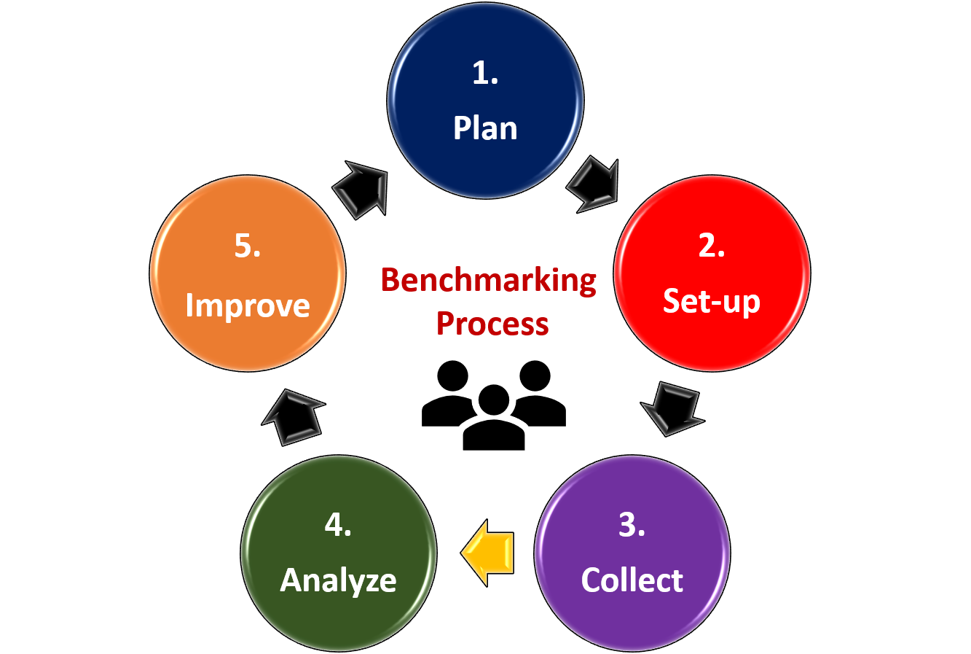Introduction
Benchmarking is a strategic approach of evaluating a set of customer-focused organizational processes, activities, and products/services, with other internal business units and externally with corporate entities in the same industry or in the broader marketplace.
As a strategic management tool, benchmarking exercises provide the “why” and “how” behind an organizations’ advantages and disadvantages with targeted competitor measures and industry ‘best practices’. The outcome is identifying the correct next steps to streamline, leverage, and exploit business processes and supporting activities, products and services, thereby, driving improved revenue, profitability, and profitability.
![]()
The purpose of benchmarking is to identify, redefine and create innovative concepts for improving processes and supporting technologies, reduce waste and cost, decrease market risk and exposure, increase profitability, and streamline and enrich customer fulfillment and loyalty interactions. Management professionals also view it as an essential tool to support continuous improvement and total quality initiatives, including Six Sigma.
Long endorsed by academia and management leaders alike, benchmarking has evolved into an indispensable tool for successful strategy development and deployment.
Benchmarking: Definition
“Benchmarking is the process of comparing and measuring your organization against others, anywhere in the world, to gain information on philosophies, practices, and measures that will help your organization take action to improve its performance. Benchmarking gathers the tacit knowledge—the know-how, judgments, and enablers—that explicit knowledge often misses.”
APQC
Benchmarking: Types & Categories
Benchmarking can be internal (comparing performance between different business units or teams) or external (comparing performance with companies in a target industry or across multiple sectors).
Within the broader types, there are four categories of benchmarking:
- Competitive Benchmarking: direct competitor-to-competitor comparison of a product, service, process, or method.
- Functional Benchmarking: comparison to similar business practices within the same or similar functions outside the organization’s target industry.
- Generic Benchmarking: broadly conceptualizes unconnected business processes or functionality in the same or similar ways despite the industry.
- Internal Benchmarking: comparison of a business process to a similar process with one or more business units inside the organization.
“What a business needs most for its decisions — especially its strategic ones — are data about what goes on outside it. Only outside a business are there results, opportunities and threats.”
Peter Drucker
Benchmarking: Executive View
Benchmarking is considered a successful instrument of organizational change and generally:
- Sponsored by executive management.
- It is driven from the top down.
- It begins and ends with customer value.
- Apply to multiple business activities, products, and locations.
- Influence by cultural, organizational, governance, and role changes.
- Accepts and implements changes representing significant productivity and profitability improvements.
“If you know they enemy and know yourself, you need not fear the results of 100 battles.”
Sun Tzu
The Case for Benchmarking
Organizations benchmark as a means of improving well-defined business areas and evaluating competitor’s successful strategies and tactics. Regardless of the impetus, identifying real-world external market representation view of the industry and competitors is a valuable input to corporate strategic planning and success in the constant struggle with domestic and international competitors.
Key business drivers for the use of benchmarking encompass:
- Competition is Intense.
- Globalization has become the norm.
- Change has become constant.
- Customers have become powerful.
“Excellent firms don’t believe in excellence – only in constant improvement and constant change.”
Tom Peters
Benchmarking: Key Performance Indicators (KPI)
Examples of generic benchmarketing KPIs include:
- Cost Effectiveness
- Cycle Time
- Growth Rate
- Headcount Optimization
- Process Efficiency
- Staff Productivity
Benchmarking: Benefits
To obtain or maintain a competitive edge in an unpredictable marketplace, organizations continually attempt to improve the efficiency and effectiveness of their internal processes and other activities throughout the enterprise.
The key benefits of business benchmarking are as follows:
- Provide invaluable empirical data to justifying innovative business cases for organizational change.
- Improve clarity and understanding of current business activities, providing better awareness of pragmatic starting points for potential change initiatives.
- Identify how the business is positioned in targeted markets and select performance measures / KPIs, as compared to competitors for industry ‘best practices.’
- Identify how ‘best-in-class’ businesses obtain and maintain high-performance levels supporting mission-critical competitive advantages.
- Identify productivity and profitability-based performance improvement opportunities.
- Streamline business and support processes and improve productivity and profitability.
- Harmonize outcomes with measures generated as key performance indicators (KPIs) within a business intelligence approach.
Benchmarking: The Process
The typical business benchmarking process consists of a set of structured steps as outlined below. Organizations need to tailor the steps for total alignment with their unique business purpose and requirements for conducting benchmarking events.

1. PLAN
- Identify the use and benefits of planned benchmarking.
- Understand benchmarking purpose positioning within the corporate strategic framework (business model, strategies, goals, and objectives) context.
- Develop Key Performance Indicators (KPI) for benchmarking goals and objectives aligned with the strategic enterprise framework.
- Map and agree on the current ‘As-Is’ process and supporting activities.
- Map and agree on the projected ‘To-Be’ process and supporting activities.
2. SET-UP
- Agree to benchmark scope and approach.
- Decide primary measures for inclusion in benchmarking.
- Settle on benchmarking method.
- Develop a data collection process.
- Identify research source target participants.
- Design a screening survey to assist with target participant selection.
- Determine how to contact and screen the target participants.
- Design online benchmarking Survey and User Interface (UI).
- Develop Scripts and supporting materials for one-on-one interviews, as required.
- Contact and obtain agreement with target participants for involvement in benchmarking.
3. COLLECT
- Conduct initiate data collection with agreed participants by agreed communications mode,
- Follow-up with participants, as required.
- Provide a copy of Interview or Survey documents, as agreed.
4. ANALYZE
- Analyze data collected on pre-defined criteria and rules.
- Decide if collected data meets original data collection objectives.
- Change data collection, as required.
- Identify performance opportunities and change initiatives.
- Develop an implementation plan with process owners and stakeholders.
- Provide participants with agreed benchmarking analysis report deliverables.
5. IMPROVE
- Set-up KPIs monitoring within the enterprise Business Intelligence system.
- Continually measure change initiative projects/programs KPIs and goals/objectives benefit realization.
- Update and continually recalibrate benchmarking projects or programs, as required.
The key driver of a successful benchmarking event is continual proactive support and approval from the executive leadership team.


